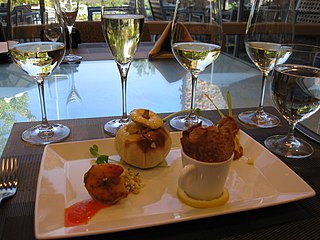
A restaurant is a business that prepares and serves food and drinks to customers. Meals are generally served and eaten on the premises, but many restaurants also offer take-out and food delivery services. Restaurants vary greatly in appearance and offerings, including a wide variety of cuisines and service models ranging from inexpensive fast-food restaurants and cafeterias to mid-priced family restaurants, to high-priced luxury establishments.

A tapa is an appetizer or snack in Spanish cuisine.

Pa amb tomàquet, is a traditional food of Catalan, Valencian, Aragonese, Balearic and Murcian cuisines in Spain. Pa amb tomàquet is considered a staple of Catalan cuisine and identity. While considered a signature toast dish in the Catalan Countries, it is common in bars throughout the rest of Spain, where it is also known as pan con tomate.

Logroño is the capital of the province of La Rioja, situated in northern Spain. Traversed in its northern part by the Ebro River, Logroño has historically been a place of passage, such as the Camino de Santiago, and its borders were disputed between the Iberian kingdoms of Castille, Navarre and Aragon during the Middle Ages.

Mazzeh, Meze,Mezze, or Mazza is a selection of small dishes served as appetizers in much of West Asia and the Balkans. In predominantly Muslim regions where alcohol is less common, Meze is often served as a part of multi-course meals, while in Lebanon, Greece, Turkey, and the Balkans, they function more as snacks while drinking or talking.

Thali or Bhojanam is a round platter used to serve food in South Asia, Southeast Asia and the Caribbean. Thali is also used to refer to an Indian-style meal made up of a selection of various dishes which are served on a platter.

Service à la française is the practice of serving various dishes of a meal at the same time, with the diners largely helping themselves from the serving dishes. That contrasts to service à la russe in which dishes are brought to the table sequentially and served individually, portioned by servants.

Pares, also known as beef pares, is a term for a serving of Filipino braised beef stew with garlic fried rice, and a bowl of clear soup. It is a popular food particularly associated with specialty roadside diner-style establishments known as Pares Houses that specialize in serving these type of meals. In recent years, it had also become a common dish served in small eateries called karinderya or carinderia that serve economical meals for local residents.

Migas is a dish traditionally made from stale bread and other ingredients in Spanish and Portuguese cuisines. Originally introduced by shepherds, migas are very popular across the Iberian Peninsula, and are the typical breakfast of hunters at monterías in southern Spain.

Chicharrón is a dish generally consisting of fried pork belly or fried pork rinds. Chicharrón may also be made from chicken, mutton or beef.

Tapa is dried or cured beef, mutton, venison or horse meat, although other meat or even fish may be used. Filipinos prepare tapa by using thin slices of meat and curing these with salt and spices as a preservation method.

Dégustation is the careful, appreciative tasting of various food, focusing on the gustatory system, the senses, high culinary art and good company. Dégustation is more likely to involve sampling small portions of all of a chef's signature dishes in one sitting. Usually consisting of many courses, it may be accompanied by a matching wine degustation which complements each dish.

Lamian is a type of soft wheat flour Chinese noodle. Lamian is made by twisting, stretching and folding the dough into strands, using the weight of the dough. The length and thickness of the strands depends on the number of times the dough is folded. This unique method of making noodles originated in China. The Songshi Yangsheng Bu, which was written by Song Xu and dates back to 1504, has the earliest description of the method to make lamian.

A tasting menu is a collection of several dishes in small portions, served by a restaurant as a single meal. The French name for a tasting menu is menu dégustation. Some restaurants and chefs specialize in tasting menus, while in other cases, it is a special or a menu option. Tasting menus may be offered to provide a sample of a type of cuisine, a house specialty, or to take advantage of fresh seasonal ingredients.

José Ramón Andrés Puerta is a Spanish-born American chef, restaurateur, and founder of World Central Kitchen (WCK), a non-profit devoted to providing meals in the wake of natural disasters. He is often credited with bringing the small plates dining concept to America. He owns restaurants in Washington, D.C., Los Angeles, Las Vegas, South Beach, Florida, Orlando, Chicago, and New York City.

Morales del Vino is a municipality located in the province of Zamora, Castile and León, Spain. According to the 2007 census (INE), the municipality has a population of 2,345 inhabitants.

The cuisine of the Community of Madrid is an amalgamation of the cuisines of various regions of Spain developed, in part, by mass migration to the capital city starting during the reign of King Felipe II. As the city grew, it incorporated the culinary traditions of the municipalities it absorbed into the area now known as the Community of Madrid.

El Jardí dels Ocells is a small bird park near the city of Vilafranca del Penedès, in Catalunya, Spain. The bird park is at about 60 km. distance from Barcelona and Tarragona and is situated about half way between these cities.

Kaiseki (懐石) or kaiseki-ryōri is a traditional multi-course Japanese dinner. The term also refers to the collection of skills and techniques that allow the preparation of such meals and is analogous to Western haute cuisine.

Silog is a class of Filipino breakfast dishes containing sinangag and itlog. They are served with various viands or ulam, usually meat dishes such as tapa, longganisa or ham. The name of the accompanying meat dish determines the portmanteau name of the silog; for example, the former three would be known as tapsilog, longsilog, and hamsilog.



















